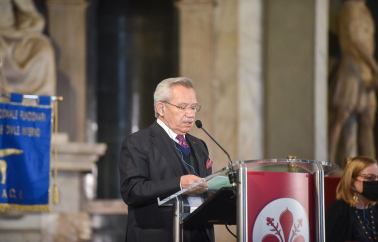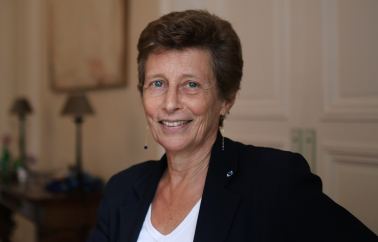
The works of governors (State Terrıtorıal Representatıves) concernıng the protectıon and restoratıon of cultural herıtage ın Turkey the examples of Istanbul and Safranbolu
INTRODUCTION
The population of Turkey is over 83 million. The management of the country depends on Provincial Administration System. Provincial Administration System has two grades. First grade is the province under the management of province governors, who are the representatives of the State and the President. The country is divided into 81 provinces. Every province is divided into districts that are governed by the district governors as the representatives of the President. Number of districts is 922. Public services are basically presented at this level. The province and district organizations of the Ministry of Culture and Tourism are responsible against province and district governors. At the level of province and district, the works of protection and restoration of cultural heritage are conducted by province and district governorates.
In this presentation, the examples will be given on the works that are conducted by province governorate in Istanbul and district governorate in Safranbolu.
THE EXAMPLES IN ISTANBUL
Emergency Response and Project Construction Works Of Inner Surface Of Ayasofya Main Hall
Ayasofya is one of the most important monuments that stood still up to date in the world architectural history. It is the biggest church built by Eastern Roman (Byzantine) Empire in Istanbul and was built three times in the same place. Ayasofya today is the third and was built to Isıdoros of Miletos (Milet) and Anthemos of Tralles (Aydın) by Emperor Justinianus (527-565). According to Historian Prokopios, the construction started in February 23, 532 and finished in 5 years. In December 27, 537 the building was opened for prayers with a ceremony. In the year 1453 after the conquest of Istanbul by Sultan Mehmet the Conqueror, it was turned into a mosque. In 1935 it was turned into a Museum with an Order of the Council of Ministers.
The reparation of the inner surface of Ayasofya main hall has started with the restoration of Northern Tympanum Wall and ground floor coverings. The west side of the Northern Wall is completed. The restoration of the east side and parts under the scaffold is still ongoing.
The Reparation and Restoration of the West Side of Ayasofya
It was completed in 2018 pursuant to ‘Ayasofya West Side Reparation and Restoration’ approved project. In this context, unqualified repairs with cement on the side are cleaned, reparations of bricks, stones and sutures are made. In addition, reparations and cleanings of marble windows and jambs are made, windowpanes are changed, west side steeples (of minarets) are repaired.
Emergency Response and Project Construction Works of Ayasofya Museum Gallery Floor, Southwest Atrium Landing Ramp Warehouses
The works in the Ayasofya Gallery Floor, which was tendered together with project and application, was started primarily by scanning with 3 dimension documentation systems and then drawing the project. After the projects are approved by the Protection Board, restoration applications have started. The restoration and conservation works for whole ground coverings of Gallery Floor and West gallery walls are still ongoing.
Chora Curch, Reparation and Restoration
The Church of Chora Monastery devoted to Jesus was the center of a big complex before. Chora means country, outside of the wall. For this reason even though it is thought that the Church was built before the construction of ground walls in 413 A.D., first certain information in the sources can be found for 9th Century.
During the Ottoman era, there has not been too many interventions that would affect the architecture of building. The most important change is the building of a minaret to the southwest corner and addition of pulpit into Naos.
The Restoration Works of Cit Pavilion, Chamber of Aides, Set Pavilion and Chambers of Drivers Surrounding Yildiz Palace Grand Sultan Pavilion
Yıldız Palace was built for Mihrisah Sultan who is the mother of Sultan Selim the 3rd (1789-1807), and then especially during the era of Ottoman Sultan Abdulhamit the 2nd (1876-1909) it was used as the main palace of the Ottoman Empire. It is located in Besiktas district. It is a complex of palaces, pavilions, administration, security, service buildings and parks that are located in a garden and grove starting from the shore and rising to northwest covering whole hillside.
Restoration of Yıldız Palace Grand Sultan Pavilion was completed including landscaping works of construction, electricity and mechanical productions. Restoration works of 4 buildings surrounding Grand Sultan Pavilion in the context of landscaping is still ongoing.
The Works for Preparation of Topkapi Palace Museum Building and Harem Buildings Partial Revision, Survey, Restitution, Restoration, Wall Maps, Infrastructure Survey Projects, Suspension of Required Structures, Making of Necessary Fortification and Integrating of Existing Projects in Digital Environment
Topkapı Palace, in Istanbul Sarayburnu, is the palace used for 400 years of total 600 years Ottoman Empire history as the state administration center and where the Ottoman Emperors lived.
Hagia Irene Church Survey, Restoration, Restition and Static, Electrical and Machinery Installation Projects
Hagia Irene Church is the largest Byzantine church in Istanbul that has not been converted into a mosque. According to sources, it was built during the reign of Constantine I (324-337) at the beginning of the 4th century, using the remains of the temples of Artemis, Aphrodite and Apollo from the Roman period. Hagia Irene was burned during the Nika Revolt in 532. Justinian I had rebuilt Hagia Irene as well as Hagia Sophia. Although the construction started in 532, the exact date of completion is not known. Severe earthquakes in the 8th and 9th centuries caused significant damage to the building. After the conquest of Istanbul, Hagia Irene remained inside the Sultan Walls (Sur-ı Sultani) that surrounded Topkapı Palace, so there was no significant architectural change since it was not turned into a mosque. Hagia Irene, which was connected to the Hagia Sophia Museum in 1939, was used as a military museum until 1949. It has been used for various artistic activities since 1983.
The supervision of the project work, the tender of which was made by Istanbul Governorate, is carried out together with the Istanbul Directorate of Surveying and Monuments. Three-dimensional scanning and documentation of the Hagia Irene Church has been completed. The survey works are in the process of being completed. Restitution and restoration and static project studies continue.
Nusretiye Mosque and Yildiz Hamidiye Mosque Installation Works
The architect of the Nusretiye Mosque, which was started to be built in 1823 during the reign of Sultan Mahmut II, is Krikor Amira Balyan, the son of Meremetçi Bali Kalfa from the first generation of the Balyan family. Its construction was completed in 1826. It is a mosque built on a square plan measuring 15.5*15.5 m, built on a high pedestal. It has a single dome. Its dome is 29 meters high and 15 meters in diameter from the inside of the mosque. It has two minarets with two balconies; The minarets are very thin and the surface is grooved. It was restored by the Regional Directorate of Foundations of Istanbul and opened for use.
Yıldız Hamidiye Mosque was built by Abdulhamid II between 1885-1886. It is one of the most typical examples of late Ottoman architecture with its mass, plan scheme and decoration. The architect of the mosque is Sarkis Balyan. The Sultan's mansion and sanctuary of the mosque present a visual integrity on a rectangular plan. Its small and high dome is seated on a polygonal drum with sixteen windows. The star embroideries on blue and the gold leaf on the sultan's pavilion, which are rarely seen in the dome decorations, are good examples of the rich embroideries of the mosque. In addition, the minaret of the building has a stalactite balcony and the body of the minaret is grooved up to the top. It was restored by the Regional Directorate of Foundations of Istanbul and opened for use.
Nuruosmaniye Mosque Installation Works
Nuruosmaniye Mosque is the first Baroque mosque built in Istanbul. It is located in Çemberlitaş district, at the entrance of the Grand Bazaar. It was built in the years 1748-1755. The mosque and its complex, which emerged at a time when Westernization trends in architecture began to be seen, are considered a turning point in Ottoman architecture. The mosque, which was built by Mustafa Ağa and his assistant Simon Kalfa, was completed under the name of "Nur-u Osmani" (Light of the Ottomans) during the reign of Osman III, who reigned for three years after the death of his brother Mahmut I. It is said to have taken its name from the Sultan Osman III and the light inside the mosque. It was restored by the Regional Directorate of Foundations of Istanbul and opened for use.
THE EXAMPLES IN SAFRANBOLU
Safranbolu, Capital of Conservation
Safranbolu District of Karabük Province, which is also known as the "Capital of Conservation", was restored and brought into tourism with the "Decision of Protection" taken by the Ministry of Culture and Tourism, High Board of Real Estate, Antiquities and Monuments in 1976.
In the historical district, which is the only place on the UNESCO World Heritage List on an urban scale in Turkey, many restoration works have been carried out in the 44 years since the "Historical and Natural Site" decision was taken, in order to carry the historical monuments to the future.
Reminiscent of the "Open Air Museum", which is also called "Ottoman's fingerprint" because it reflects the Ottoman architecture, city life and culture, and where there are inns, baths, mansions, fountains, mosques and bridges from that period, citizens are also protected. By adopting the awareness, it contributes to the historical texture coming to today and transferring it to the future.
House of District Governors and Scarves Bazaar
In 1979, the Scarves (Yemeniciler) Bazaar and the House of District Governors were restored and are the first examples of protection and consolidation of Safranbolu.
Asmazlar Mansion with Pool, known as the largest mansion in the region, was put into service as a boutique hotel in 1989 after the restoration.
Museum of City History (Former Governor’s Office)
After the restoration works, it was opened as the Museum of City History in 2007. Restoration work continues.
Historical Prison and Clock Tower
Restoration works of the historical prison and the historical clock tower were carried out; landscaping work continues.
Hıdırlık Hill
The restoration work was completed in 2006.
Schoolers (Mektepciler) House
Schoolers (Mektepciler) House, which draws attention with the decorations on its wall, was restored in 2006.
Practice Guest House
The restoration of the mansion was completed in 2007. It is in use as a Guest House.
Practice Hotel
The mansion was restored in 2006 and is in use as a Practice Hotel.
Safranbolu Teacher's House
After the restoration in 2006, it was put into service as Teacher's House.
Safranbolu Akcasu Canyon
Akcasu (Pure Water) Canyon, whose restoration was completed in 2018, is in the center of Safranbolu historical bazaar.
Freckle Clerks' Mansion
This mansion was restored in 2005 and started to serve as an official institution.
Hilmi Bayramgil Street
The facades and roofs of 18 houses on this street were restored in 2006.
CONTRIBUTION OF GOVERNORS (STR) TO RESTORATION WORKS
Governors, who are at the head of the general administration in the provinces and districts where they work in Turkey, undertake important functions in the protection of historical heritage.
In this context, they play an effective role in protecting historical monuments, ensuring their safety, carrying out restoration works and transferring this cultural heritage to future generations.



